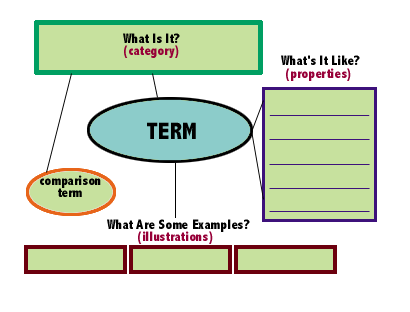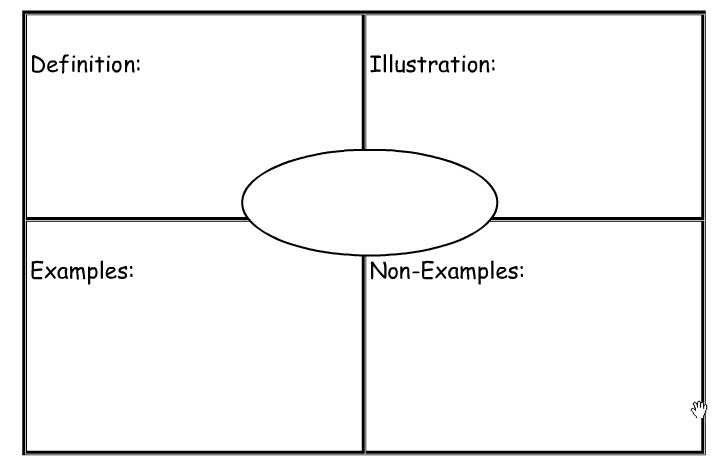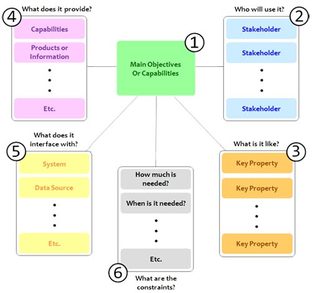Teachers needs to "incorporate vocabulary instruction into literacy curriculum" (Jennings, Caldwell, and Lerner, 2014).
Concept of Definition Map
Definition/Description: A type of diagram or graphic organizer which shows various relationships between concepts. Concept mapping provides students with the opportunity to organize conceptual information in the process of defining a word.
|
Justification:
"Studies suggest that an effective way to build conceptual understanding is to combine words with visual images" (Miller, Veatch, 2011). Marzano’s six step process for teaching academic vocabulary demonstrates that when visually see the word, put the word into a sentence, and find a synonym and antonym it helps them learn the word, not just memorize the word. He did a lot of research on the impact that graphic organizers, such as ones used in CM, have on students vocabulary learning (Marzano and Pickering. 2005). Beck, McKeown, and Kucan research shows that when students are working with tier 2 or 3 words that they need more than just a definition. Students need a visual or something to relate it to, such as a synonym (Beck, McKeown, and Kucan, 2008).The Frayer Model is an adaptation of the concept map. The framework of the Frayer Model includes, concept word, definition, characteristics, examples, and non examples of the concept word. Dr. Frayer and his colleges created this framework for directly teaching words to support concept development. Based on their personal research they new that in order for students to learn and obtained a certain word and definition that they needed to write it down in more than one way as well as visualize it. (Marzano and Pickering, 2005)"Struggling readers and writers may lack this language-rich background or may need more explicit help to benefit from exposure to rich language and literacy experience" (Jennings, Caldwell, and Lerner, 2014).This statement represent the importance of incorporate vocabulary strategies to help struggling reader gain the understand and knowledge needed to be successful in literacy skills and development. |
|
"Map, helps build a broad, multidimensional meaning of a word"
(Miller and Veatch, 2011).
|
Steps:
This video is sort of lengthy, however it sums up what concept maps are, how to create them, and how teacher can use them in their classroom. It is a great video to watch for teacher who are trying to implement the strategy in their classroom.
|
Purpose:
To support vocabulary and concept learning for students by having them define and clarify the meaning of unknown words. Students take a key term, concept, or reading selection and display their finding using a graphical organizer. Students place information in logical categories, identify defining properties and characteristics, and offer examples and or non-examples of ideas. This strategy is especially useful for analyzing brief, but content-rich, reading selections. There are many different types of CM. One of the most used is is semantic mapping. The Three components: - Category - What Is It? - Properties - What Is It Like? - Illustrations - What Are Some Examples? Two things to remember about Concept word maps: - they work best with nouns - they should not be used for defining lists of vocabulary words |
|
Content Area:
Since concept of definition maps are using vocabulary to help depend student understanding it can be used in any content area, for any topic, and related to any curriculum. Examples:
|
References:
Beck, I., McKeown, M., & Kucan, L. (2008). Bringing Words to Life Robust Vocabulary Instruction. The Guilford Press.
Concept Maps: How Instructors Can Use Them to Support Student Learning (2011). [web video]. Retrieved from https://www.youtube.com/watch?v=Po-aj31WXsM
Frayer Model Graphic Organizer (n.d). [image]. Retieved form http://abridental.com/frayer-model-graphic-organizers
Jennings, J., Caldwell, J., & Lerner, J. (2014). Reading problems assessment and teaching strategies. Boston, MA: Pearson Education, Inc.
Jones. R. (2014). Concept of Definition Map. [image]. Retrieved form http://www.readingquest.org/strat/cdmap.html
Marzano, R & Pickering D. (2005). Vocabulary (Teacher’s Manual). ASCD.
Miller, M., & Veatch, N. (2011). Literacy in Context (LinC): Choosing Instructional Strategies to Teach Reading in Content Areas for Students Grades 5-12. Pearson
Semantic Mapping Lesson. (2011) [web video]. Retrieved from https://www.youtube.com/watch?v=8rPdl_O3aaE
Beck, I., McKeown, M., & Kucan, L. (2008). Bringing Words to Life Robust Vocabulary Instruction. The Guilford Press.
Concept Maps: How Instructors Can Use Them to Support Student Learning (2011). [web video]. Retrieved from https://www.youtube.com/watch?v=Po-aj31WXsM
Frayer Model Graphic Organizer (n.d). [image]. Retieved form http://abridental.com/frayer-model-graphic-organizers
Jennings, J., Caldwell, J., & Lerner, J. (2014). Reading problems assessment and teaching strategies. Boston, MA: Pearson Education, Inc.
Jones. R. (2014). Concept of Definition Map. [image]. Retrieved form http://www.readingquest.org/strat/cdmap.html
Marzano, R & Pickering D. (2005). Vocabulary (Teacher’s Manual). ASCD.
Miller, M., & Veatch, N. (2011). Literacy in Context (LinC): Choosing Instructional Strategies to Teach Reading in Content Areas for Students Grades 5-12. Pearson
Semantic Mapping Lesson. (2011) [web video]. Retrieved from https://www.youtube.com/watch?v=8rPdl_O3aaE



